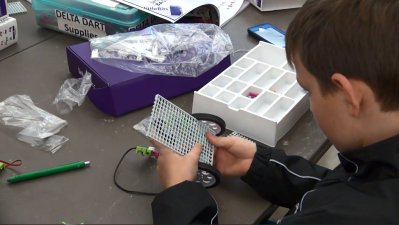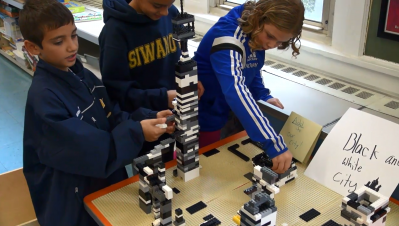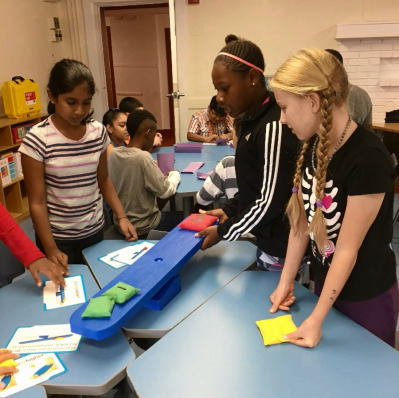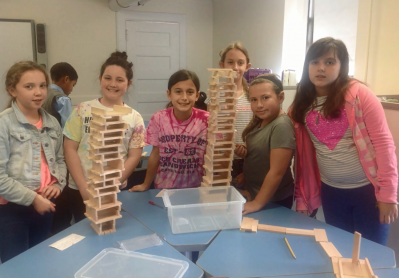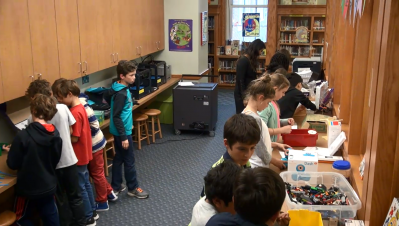Pelham Public Schools - Making It A Reality
Competing priorities can challenge efforts to stimulate creativity and ingenuity in the classroom. Pelham Public Schools embarked on a multi-year mission to systemically integrate learning experiences to prepare students to succeed in the new century. By building community partnerships, the district explored and implemented ways to develop makerspaces in each school, opening minds to student and teacher innovation and collaboration.
We constantly read and hear about the need to prepare students for the 21st century and the jobs of tomorrow. Similar calls for schools to focus on specific skills in education echo the 1990s, as we sought to build a “bridge to the 21st century.” Remember the Secretary's Commission on Achieving Necessary Skills (SCANS) Report? There are definite links between that work and current trend for students to think critically and creatively, collaborate and communicate, integrate technology, and become a global citizen. Yet the advent of high stakes testing and assessment-driven teacher/principal evaluations with No Child Left Behind and Race To The Top challenges efforts to stimulate creativity and ingenuity in the classroom.
Pelham Public Schools, which is located in the suburbs just outside New York City, embarked on a mission to systemically integrate learning experiences to prepare students to succeed in the new century. As part of our strategic plan, we sought to implement a clearer K-12 STEAM strand to reach all children in the organization. Michael Fullan’s (2001) research on educational change revealed that systemic innovations take a minimum of 2 to 3 years, while institutional reforms require 5 to 10 years. However, we endeavor to foster rapid progress in teaching and learning. Our paradigm shift to advance 21st century learning came in the form of the Maker movement.
A makerspace is a cross disciplinary learning environment that promotes active learning through play, offering materials and tools encouraging students to create rather than consume (Krueger, 2014). The “Maker Philosophy” follows the belief that if you can imagine it, you can make it (Hlubinka et al, 2014). Making connects with our advocacy of Carol Dweck’s (2006) Mindset. Furthermore, our thoughts were validated in the 2015 documentary Beyond Measure, which highlighted the importance of critical thinking, communication, exploration, experimentation, collaboration, and creativity as ingredients for good education (Abeles, 2015). We believe that makerspaces help us achieve this vision.
There were three factors that we needed to resolve in developing makerspaces in our schools: time, support, and money. We agreed upon a two-year research, planning, and implementation timeline to expedite Maker experiences in a reasonable period. We wished to capitalize on this exciting prospect as soon as possible, yet we understood the need for due diligence. In New York State’s tax cap era, we must be cognizant of competing fiscal forces that pull across the system. Therefore, we sought partnerships within our school community as the best approach to realize our Maker dream.
After some visits to neighboring school districts and libraries, we established a team of stakeholders to lead our efforts. A “Makerspace Exploratory Team” of teachers, students, administrators and parents embarked on an extensive study to examine the prospect of creating such learning environments in Pelham. Our team encompasses learning community members from all six schools in our district, each contributing valuable insight and skills. Members visited schools, participated in professional development, and attended the NYS Maker Faire. Members read Laura Flemming’s Worlds of Making (2015), and our administrators examined Tony Wagner’s Creating Innovators (2015) to prime their thinking. Teachers on our team became STEAM coaches, as we prepared them to be Maker leaders in their schools. Likewise, we invited our principals to be part of the team as it was necessary to personalize any new learning experiences in their buildings. Meanwhile, we initiated communication with our local benefactors, the Pelham Education Foundation, and showcased a model makerspace at their annual “Exploratorium” event.
A key commodity in our district is space, which is very limited due to our older facilities, size, and growing enrollment. We discovered that the old desktop computer lab spaces were obsolete and ripe for reconditioning. Our 7-12 students are all assigned Chromebooks, and we decided to replace elementary desktops with similar mobile devices. This provided us with the opening to use these locations as new makerspaces.
Our team developed a wish list of materials, supplies, and equipment purchases (i.e. LittleBits, Dot & Dash, 3D printers, crafts) and new mobile furnishings for the makerspaces. Each school principal established their own team to identify specific themes for their makerspaces (engineering, inventing), and invited students to name new their learning place (like Imagination Station). We wrote a comprehensive grant to the Pelham Education Foundation for financial support, and they graciously bestowed $200,000 to the district. We devised summer, school year, and outside professional development opportunities for our teachers to prepare for makerspace openings at the start of the 2016-17 school year. We opened makerspaces in each of our six schools when students arrived in September.
Our 2016-17 goal was to literally and figuratively unpack the makerspaces in all our schools. We allowed our teachers and students to explore organically, find connections in their curriculum, and enable children free time to tinker, play, and create. Other lessons learned from this year include the need to implicitly find links with the new Science standards, offer more real-time professional development for teachers, and examine elementary staffing options for additional support. However, the most important lesson learned was discovering a recipe for success: building community partnerships by promoting our educational values. Our journey continues.
References
Abeles, V. (Director). (2015). Beyond Measure [Motion picture]. USA: Reel Link Films.
Dweck, C. S. (2006). Mindset: The new psychology of success. New York: Random House.
Fleming, L. (2015). Best practices for establishing a Makerspace for your school. Corwin: Thousand Oaks, CA.
Fullan, M. (2001). The new meaning of educational change: Third edition. Teachers College Press: New York, NY.
Krueger, N. (2014). Create a school Makerspace in 3 simple steps. ISTE.
Hlubinka, M., Dougherty, D., Thomas, p., Chang, S., Hoefer, S., Alexander, I., McGuire, D.,Vanderwerff, A., and Scott, B. (2013). Makerspace playbook. MakerMedia.
Contact
Dr. Steven M. Garcia, Assistant Superintendent for Curriculum, Instruction & Personnel, Pelham Public Schools, sgarcia@pelhamschools.org






